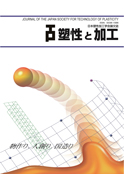
- |<
- <
- 1
- >
- >|
-
Masami KOJIMA, Shigeru NAGASAWA, Yuichi IGARASHIArticle type: research-article
2020Volume 61Issue 708 Pages 1-6
Published: 2020
Released on J-STAGE: January 25, 2020
JOURNAL FREE ACCESSThis research work is intended to reveal the cutting characteristics of a Shore A hardness of 50 silicone rubber sheet, which was stacked on a Shore A hardness of 90 silicone rubber underlay, indented with a 13.9° tungsten carbide blade. In a previous report (Mitsomwang et al., 2014), the velocity-dependent response was not sufficiently discussed. The cutting velocity of the blade was chosen to be in the range of 0.00167-0.29 mm∙s-1 to investigate the cutting characteristics derived from Eq. 5 the first inflection point P1 and the peak maximum point Pmax in the relationship between cutting line force and indentation depth. The correlation of points P1 and Pmax with the in-plane tensile testing characteristics was revealed with respect to feed velocity. Also, a dependence of the roughness of the cut surface on the cutting velocity was observed.
View full abstractDownload PDF (1351K) -
Toshiro OKAZAKI, Yukio KIMURA, Hideo KIJIMA, Masaru MIYAKEArticle type: research-article
2020Volume 61Issue 708 Pages 7-12
Published: 2020
Released on J-STAGE: January 25, 2020
JOURNAL FREE ACCESSIn temper rolling of double reduced thin strips, shape defect called “longitudinal buckling” appears. In previous study, the effect of several rolling conditions on the longitudinal buckling was investigated. However, effect of delivery angle over 4 degree has not been experimented. In this paper, effect of large delivery angle is investigated in laboratory rolling. Results show that by increasing delivery angle, the buckling appears clearly and the number of waves decreases, and by the delivery angle over 24 degree the buckling disappears. If the delivery angle is the same, the buckling form does not change by the distance between work roll and auxiliary roll. Next we calculate the buckling characteristics of the sheet which twines around the work roll by the elementary theory. We find that the change of number of waves by the delivery angle calculated from the analysis almost agrees with the experimental result when the delivery angle is larger than 10 degree. It is estimated that the longitudinal buckling is initiated around roll gap and changes under the influence of the shape of sheet which twines around the work roll.
View full abstractDownload PDF (841K) -
Chikako HIROMI, Shigeru TSUCHIDA, Futoshi KOZATO, Hiroko MIKADO, Shing ...Article type: research-article
2020Volume 61Issue 708 Pages 13-19
Published: 2020
Released on J-STAGE: January 25, 2020
JOURNAL FREE ACCESSSmall zipper elements are manufactured by successive plastic deformations of a preformed wire. However, when designing a new zipper chain, it is difficult to obtain an optimal zipper element shape without having to conduct several forming tests. To reveal deformation behavior from a preformed wire processed into zipper elements, we aim to clarify the shearing mechanism of a preformed wire. Using the results of observations with an optical microscope, SEM and X ray CT on the sheared surface, we elucidated how the shearing of a preformed wire occurs. First, a crack is initiated at the leg area from both punch and die sides. Second, as the shearing progresses, the crack expands, and dimples on the fractured surface on the punch side are compressed by contact with the die surface. Finally, the head part is broken by the moment from the punch to leave a rough dimpled surface.
View full abstractDownload PDF (2608K) -
Nobuyasu NOMA, Koji HASHIMOTO, Taiki MAEDA, Toshihiko KUWABARAArticle type: research-article
2020Volume 61Issue 708 Pages 20-25
Published: 2020
Released on J-STAGE: January 25, 2020
JOURNAL FREE ACCESSThe strength differential (SD) effect, i.e., the difference in flow stress between tension and compression, of a high-strength cold-rolled steel sheet with a tensile strength of 980 MPa is measured using an in-plane tension-compression test apparatus. Biaxial tensile stress tests are also performed to measure the contours of plastic work of the test material. From the experimental results, a material model that can reproduce the SD effect is determined. Furthermore, this material model is implemented into the commercial FEM code LS-DYNA using a user-subroutine function. To validate the accuracy of this material model, curved hat panel forming without a blank holder is carried out. By comparing the experimental and forming simulation results, we validated the influence of the SD effect on the enhancement of the predictive accuracy of springback.
View full abstractDownload PDF (802K)
- |<
- <
- 1
- >
- >|